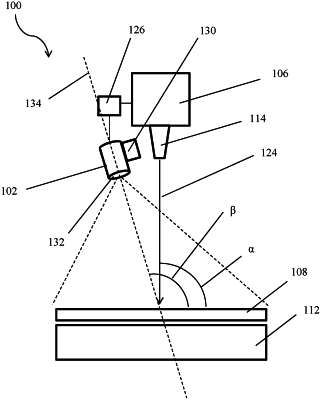| CPC G01J 3/36 (2013.01) [B22F 10/20 (2021.01); B22F 10/25 (2021.01); B22F 10/28 (2021.01); B22F 12/44 (2021.01); B22F 12/45 (2021.01); B22F 12/90 (2021.01); B33Y 50/02 (2014.12); G01J 3/0208 (2013.01); G01J 3/443 (2013.01); B22F 10/30 (2021.01); B22F 10/366 (2021.01); B22F 10/38 (2021.01); B33Y 10/00 (2014.12); G01J 2003/1213 (2013.01)] | 19 Claims |

|
1. A multi-spectral sensor, comprising:
a receiver configured to receive electromagnetic emissions from a material and transmit the electromagnetic emissions to a splitter, the receiver being an optical receiver having an optical receiver axis, wherein the optical axis forms an angle β with respect to the surface of the material, the optical receiver is a distance d from the surface of the material;
the splitter configured to split electromagnetic emissions from the material into a first light beam and a second light beam, the first light beam corresponding to line emissions of a component of the material, the second light beam corresponding to continuum emissions of the component of the material;
a first filter configured to receive the first light beam and pass light having wavelengths within a range about the line emissions of the component of the material and block or attenuate light having wavelengths outside the range about the line emissions of the component of the material;
a second filter configured to receive the second light beam and pass light having wavelengths within a range about the continuum emissions of the component of the material and block or attenuate light having wavelengths outside the range about the continuum emissions of the component of the material;
a processor configured to:
generate line data, SLine, representative of an intensity of the first light beam, SLine, being independent of d and/or β;
generate continuum data, SContinuum, representative of an intensity of the second light beam, SContinuum being independent of d and/or β;
generate a value based on the SLine and SContinuum.
|